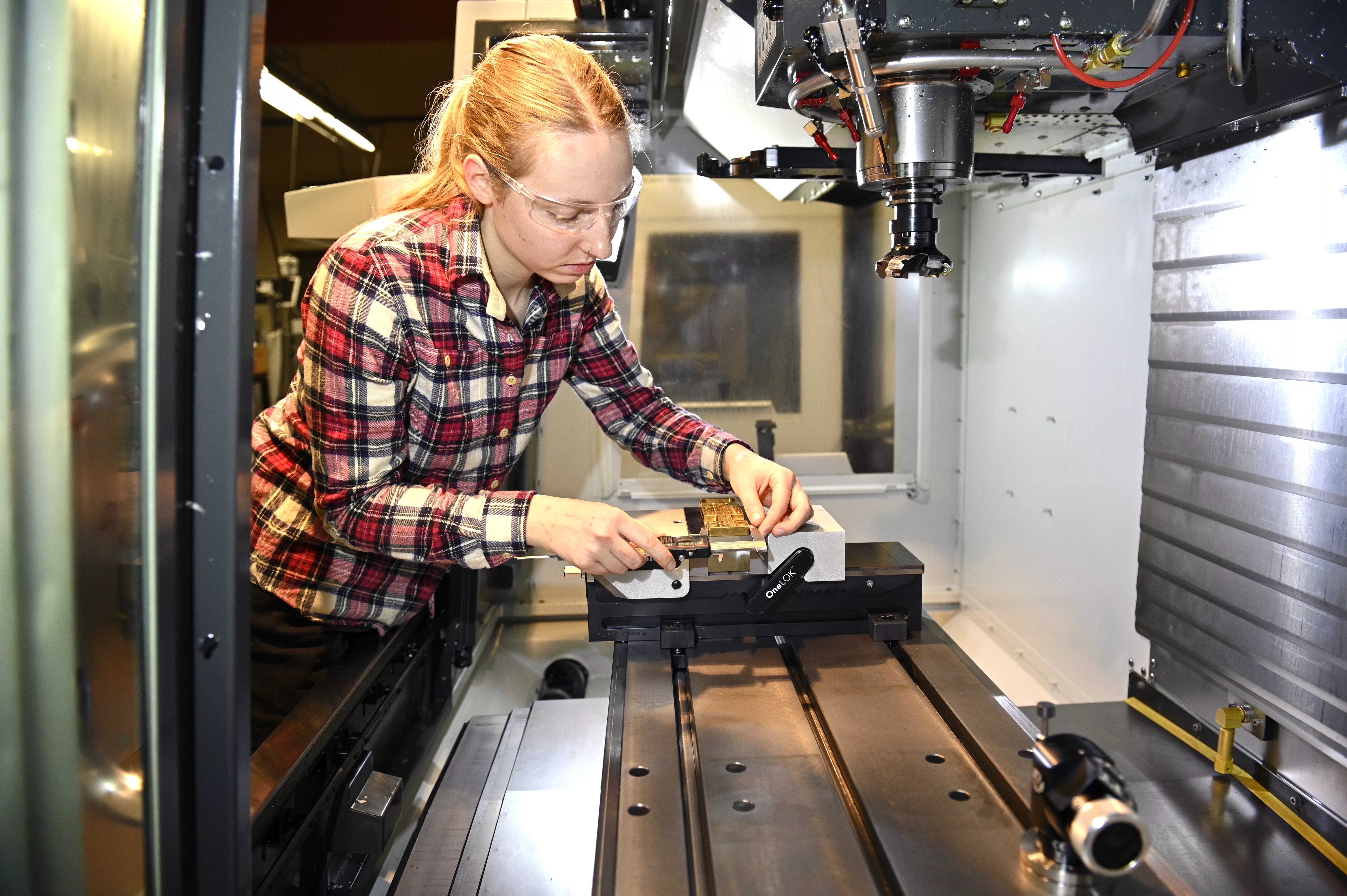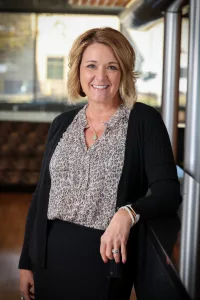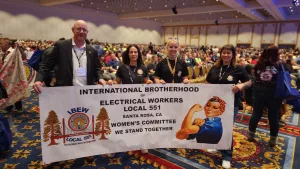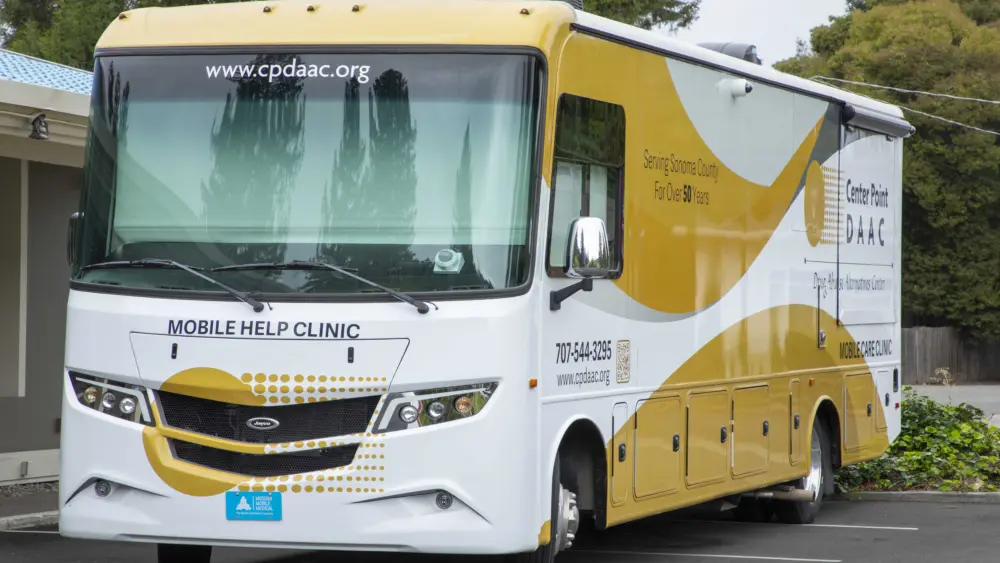
A female machine shop student at Santa Rosa Junior College. Photo credit: Santa Rosa Junior College
Being a woman in the trades means working against stereotypes, in fields in which few women are present and on a schedule that makes it difficult to care for children and aging parents. Yet the rewards are great: economic stability, allowed by the high wages and benefits packages and the chance to learn and improve valuable skills. There are also opportunities to mentor other women entering one’s field.
In the North Bay, organizations that train women in the trades include unions, community and four-year colleges and professional associations. These organizations are proactive and interested in outreach, but it is still difficult to recruit and retain women. Entities are countering this concern by offering programs at all levels: K-12, pre-college, college and workforce.
The idea is to interest and, hopefully, graduate candidates who develop a high degree of excitement about the trades and will recruit other women.
In 2018, Stephanie Hall was the only woman in the graduating class from the Redwood Empire Electrical Training Center, an apprenticeship program for the International Brotherhood of Electrical Workers (IBEW) Local 551. “This is why in 2020, I helped start the Women’s Committee for IBEW 551,” says Hall, who’s the women’s committee chair as well as outreach coordinator for the union. “My goal is to show women the trades is an opportunity for you to prove who you are and what you want to become. My organization is here to help you do that, not to turn you away.”
Alondra Perez, a welding technology student at Napa Valley College, says she also reaches out to other women entering the field.
“Other women did this for me and that’s why I’m doing it. I want female students beginning in fields like machining to say, “If Alondra did it, so can I. And I can ask her questions to understand what it will take,” says Perez.
Overcoming the odds
In 2023, the number of American women in the trades increased to its highest level yet: 363,651 individuals in construction and extraction jobs. This represents an appreciable gain from the 2021 figure of just over 314,000 women in the trades. The data come from the Institute of Women’s Policy Research, a D.C.-based nonprofit that seeks to close inequality gaps. The rise in numbers has come at a time when women have been looking for better wages and stability, after suffering higher job losses and more salary dips than men during the COVID-19 pandemic.
Still, in 2023, tradeswomen represented only 4.3% of the trades workforce. Approximately 3.1% were carpenters, 2.9% electricians and 2.2% plumbers, pipefitters and steamfitters. It is critical for organizations that recruit women to build a robust support system and foster a culture of acceptance, says Dr. Kay Ramsey, CEO of Tradeswomen, Inc. The organization is an Oakland-based nonprofit that offers services to train women in the trades and meetups for them to build camaraderie.
“Many women question whether they can truly succeed in these roles. Moreover, societal stereotypes often discourage women from pursuing nontraditional male-dominated professions. This lack of support can be disheartening, with some facing ridicule or resistance from family and peers when attempting to change career paths,” says Ramsey.
Women who enter programs also face concerns such as a lack of pay during the program period and a problem obtaining childcare. These issues go hand in hand with food insecurity, a need for mental health support and a need for travel assistance. Tradeswomen, Inc. counters this by partnering with pre-apprenticeship programs that provide supportive services and a stipend for participation.
Christina Junker is the executive director of Marin City Community Development Corporation (CDC), an employment-focused nonprofit in Marin City. The Marin City CDC partners with the Northern California Laborers Training Center in San Ramon, the Laborers International Union of North America (LIUNA) and the California Department of Rehabilitation to offer supportive services like those Ramsey describes.
For example, the Marin City CDC provides tools for up to 20 participants per cohort, a modest stipend and pays for three months of union dues. It also educates participants on financial literacy, soft skills like how to interview for a job and mental health support.
“We’ve been offering our enhanced eight-week construction trades program for two years. For this recent cohort, of the 75 applicants, eight are women. These eight applicants were dealing with a number of difficulties, including a lack of childcare and transportation and living without shelter, as well as dealing with the stigma of being a woman in construction. We diligently work to gain their trust since they do not readily share their needs at first,” says Junker.

“We recognize clients’ issues with respect and dignity by providing them with person-centered and case-management services. We are grateful to our funders and partners for making this unique program possible.” says Junker.
Hall says her story began like those in the Marin City CDC’s program, when she was working at a dead-end job.
“My brother was in IBEW and told me about what kind of money I could be making. When I first started, I didn’t like it right away. But I stuck it out and found out what I like to do. I tell women to keep at it. You may not like an activity until you do it for at least a month,” says Hall.
Ayanna Bell is an apprenticeship coordinator with the Northern California Carpenters Training Center, based in Pleasanton. She has traveled to Marin, Napa and Sonoma counties to talk to women interested in or working in carpentry.
“Before that I worked with children and later at an agency that did background checks. I was making $10 an hour. At one point, I learned I might get a raise of three cents a year. Wanting to be able to provide for myself and make a livable wage pushed me to apply for a four-year apprenticeship program,” says Bell.
Building a community, starting in middle school
The term “Career Technical Education” (CTE) refers to classes that prepare students for a variety of careers, many of them in the trades. Examples include the construction technology and engineering and manufacturing technology classes at sites such as Napa High School and Petaluma High School . Other programs, like the Tinker Academy in Sonoma County, spark the interest of middle school students, a number of them girls. This encourages the participants develop an interest in STEM and trades-related classes they may take in high school or beyond.

The Tinker Academy is a remedy for that, she says. “By providing an engaging STEM environment with like-minded girls and young women, participants gain self-confidence and motivation to pursue these career pathways,” says Goodacre.
The education continues in high school with CTE classes and programs like the North Bay Construction Corps (NBCC), a basic construction training program for seniors in their last semester of high school. This Sonoma County program offers classes taught by local contractors and construction managers. The classes introduce students to a variety of trades.
Another avenue for training is the North Coast Builders Exchange (NCBE), a Santa Rosa-based association for construction companies in Lake, Mendocino, Napa and Sonoma counties.
“In 2023, of the 83 students participating in the NBCC, five were women,” says Lisa Wittke Schaffner, CEO of NCBE. “We realized women entering the field and already in the field need more support. That’s why in 2024, we started a new group for female construction professionals, Empowering Women in Construction.”
There is a tremendous need for women in the trades to find peers who support and listen to them.
“Several members of the Empowering Women in Construction group are the only woman in their company. One of the most popular topics of discussion so far has been how to negotiate, personally and professionally,” says Wittke Schaffner.
Mara Slack, a student in the machine tool technology program at Napa Valley College, developed an interest in the trades by taking woodshop in middle school. When she attended high school in west Sacramento, there were no shop classes available.
She worked at other jobs for decades but eventually returned to hands-on work. She is now close to 40 and has already completed the welding technology welding technology program at Napa Valley College.
“I think starting young really helps women,” says Slack. “Having family ties also helps. My grandfather was a stationary engineer in the U.S. Navy. I grew up watching my grandfather repair pipes, working first as a boilerman for Libby’s and later for Tri Valley Growers. It’s a good idea for programs to ask girls and young women what relatives inspire them.”
New paths in career education are always in development. In August 2024, Santa Rosa Junior College will open the Construction Training Center in Petaluma. The center will offer classes in carpentry and residential heating, ventilation, air conditioning and refrigeration (HVAC-R).

Goldstein says it is important to make every student feel welcome. SRJC does this by addressing common misconceptions about the construction industry and highlighting the importance of a dedicated work ethic over physical strength.
“Creating a better space for everyone is also about the little things, like providing personal protective equipment like safety vests and hardhats in a variety of fits and sizes. We want to offer PPE that fits everyone,” says Goldstein.
Better outcomes, even with challenges
County commissions are on board with the goal of increasing the number of women in the trades.
Gina Fortino Dickson, chair of the Sonoma County Commission on the Status of Women, believes having more women in the trades would increase the median income for women. “It would also open up opportunities for them to train others and start their own companies,” says Fortino Dickson. “Much of the work that women do, like housekeeping, silos them. They may not get to move up or make much more, even after years of work.”
In 2024, the Commission rewrote its mission to put a new focus on economic freedom.
“Women who enjoy economic independence have the freedom to make choices, like train to acquire a new skill. We invite women who are in the trades to share stories with our commission. That will allow us to understand what we can do to help develop allies for them within the community,” says Fortino Dickson.
Jessica Coulman, a Rohnert Park-based apprentice electrician with IBEW Local 551, says it is key that women who are used to working with men teach other women to be less apprehensive.
“I used to race at Sonoma Raceway a lot and it’s mostly men there—that helped,” says Coulman. “I also did independent study in high school so I could have more time to play sports. I got used to being the only girl on many teams, from Little League when I was younger to basketball when I was older.”
Adds Coulman: “Women can be scared of working in a majority-male workplace. Yet men can be funny and helpful.”
Susan Rodriguez, field representative for the Northern California Carpenters Union, says gender bias exists.
“The Carpenters Union and employers shall work collaboratively to improve recruitment, retention and viable work opportunities for women, minorities and any other protected classes,” says Rodriguez. “In 2021, the Northern California Carpenters Union ratified its collective bargaining agreement to include the inclusive language.”
Bell says practices like a union’s “ready to work” list at a hiring hall help eradicate gender-based discrimination.
“The contractors who hire from that list cannot skip a worker who happens to be a woman. There were times I showed up to work and was rejected on the spot. I handled that by saying, ‘OK, I’ll see you next week.’ I’d show up again at their door. Eventually they got tired of seeing me and I got the job. Then they kept me because they saw how well I did the job,” says Bell.
Views from men in the trades
Locally, many men in the trades would like to see women working alongside them. John McEntagart, business manager and financial secretary for IBEW Local 551, says in his third year of the electrician apprenticeship program, another apprentice, Denise Anderson, made a huge impression on him.
“She was two years behind me in the apprenticeship. Her work ethic was phenomenal. After she graduated, she quickly became a foreman. She was not just good at her job. She was a leader,” says McEntagart.
Anderson’s achievements showed McEntagart all you need to be an electrical apprentice in the union is a good work ethic.

Rob Barsi is the training director of Redwood Empire Electrical Training Center. He wants to raise the number of women in the center’s program above the current figure, 3%. There have been only five female graduates over the past six years.
“When women get in, they usually excel. The question is how to encourage them to apply. Right now, we’re waiting to receive funds for outreach from California’s new Equal Representation in Construction Apprenticeship (ERiCA) grant,” says Barsi.
The ERiCA grant is meant to create career pathways for women, non-binary and underserved populations into careers in building and construction. It will provide $5,000 for childcare for those in a pre-apprenticeship program and $10,000 for childcare for those in an apprenticeship program.
Doug Marriott, senior dean, career education and workforce development at Napa Valley College, says the job market is excellent for individuals who complete training in the trades.
“When we have women in the program, they usually get placed right after they graduate. Sometimes they get jobs in the field before they graduate. I see departures like this as ‘positive attrition,’” says Marriott.
Perez, who is bilingual in Spanish and English, has already earned an overhead certification for welding. She has also developed an area in which she wants to specialize: fabrication.
“I’m ready to work in a shop and incorporate all the skills I’ve learned, like designing blueprints for welders,” says Perez. “Yet the things I learned from two women ahead of me in this program were also part of my education. This included sticking together, the tips and tricks they shared and them taking extra time to watch me practice.”
Adds Perez: Them being there for me put me in a better position to help myself and others.”
Editor’s Note: An earlier version of this story misidentified the base location of Tradeswomen, Inc. The tradeswomen advocacy nonprofit is based in Oakland.



